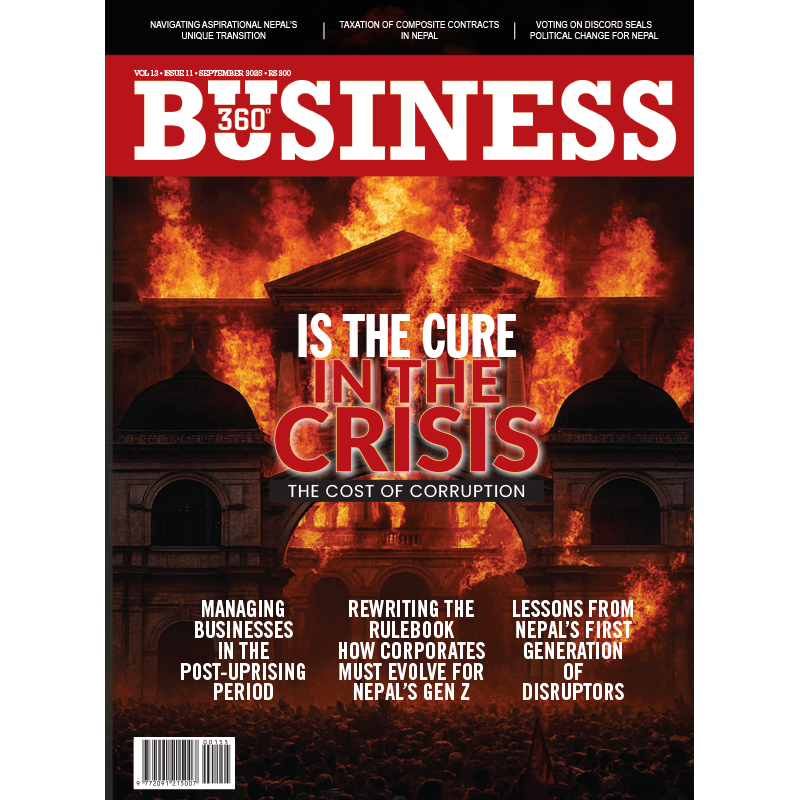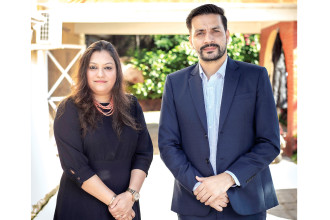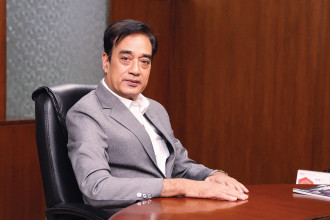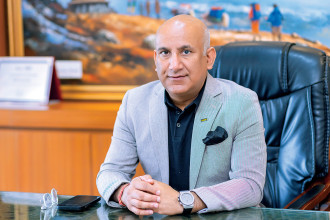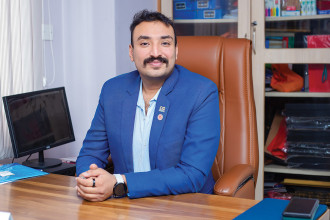-1724655281.jpg)
With over 16 years of experience in digital marketing, Rohan Chincholi, Chief Digital Officer at Havas Media India, is a seasoned expert who has been an integral part of Havas for more than 14 years. A TEDx speaker, Chincholi’s career highlights include setting up the digital chapter of Network Advertising and working on augmented reality with Blippar India.
In 2017, Chincholi rejoined Havas Media Group with a mandate to grow the digital business across markets. He holds a distinction in Cyber Contracts and Cyber Crimes from NALSAR Institute, Hyderabad, and is a certified specialist in Cyber Law. His extensive client portfolio includes Tata Motors Commercial, DS Group, DeBeers, JBL, Harman, Voltas, Voltas Beko, ICICI Securities, Bira91, Swiggy-Instamart, Eurogrip Tyres, M3M, Carlelo, Magicbricks and Scaler, among others.
Chincholi’s impressive list of accolades includes being recognised in the Social Samosa 40 under 40 and Agency Reporter 40 under 40 lists. He has also been honoured as Havas APAC’s Planner of the Year and Staff of the Year in 2012. Currently, Rohan is spearheading the launch of CONVERGED in India – an identity-based audience planning platform with a third-party audience pool exceeding one billion in volume and over 13 taxonomies. Chincholi was recently in Kathmandu as a resource person at a programme titled ‘Learning Curve’, organised by Catalyst in conjunction with Business 360. Excerpts of a conversation on the different aspects of digital marketing and emerging trends.
How do you see the digital marketing landscape evolving and what emerging trends or technologies do you believe will have the most significant impact on brands and consumers?
The digital marketing landscape is an ever-evolving spectrum of media, creative and technology, all working together to meet brand Key Performance Indicators (KPIs). Its complexity is enormous, but its ability to provide comprehensive end-to-end measurement and focus on Return on ad spend (ROAS) makes it the media of choice for most advertisers. Digital platforms are prioritised over traditional media due to their superior tracking capabilities and two-way interaction potential.
“In today’s influencer marketing landscape, evaluating influencers goes beyond followership. At Havas, we use Havas Klug, an advanced methodology assessing influencers on over 23 variables, including follower quality, notable followers, suspicious followers, past brand associations, work cloud and category relevance. This ensures our selections are data-driven and aligned with strategic goals. By leveraging Havas Klug’s expertise, we have observed notable improvements in campaign delivery, proving that even influencers with smaller followings can drive substantial engagement when selected based on comprehensive metrics”
Key trends shaping the industry include
Video content over static imagery: This preference driven by low-cost data and entry-level smartphones, enhancing engagement and reach is on the rise. Audio-Visual (AV) planning is increasingly focused on over-the-top (OTT) platforms, online video, and connected TV (CTV), e-commerce, reflecting evolving viewer preferences.
The emphasis on e-commerce and Direct-to-Consumer (D2C): With a renewed focus on driving online sales and revenue growth we are seeing heightened focus in this segment as well. Social commerce opportunities are maximised through strategic utilisation of social media platforms, key channels for customer interaction and transactions. Content creators and influencers are becoming primary drivers of brand visibility and advocacy, surpassing traditional branded content to enhance authenticity and audience connection.
Efficiency with Generative AI (GAI), a subset of AI, represents a significant shift in the industry, enabling content creation at the click of a button. This technology is scalable and effective for campaigns, positively impacting media efficiency by reaching relevant audiences with precision. While it offers tremendous potential for creativity and innovation, GAI also raises ethical concerns regarding originality, copyright, and potential misuse.
Age of experience: In India’s dynamic e-commerce landscape, several online brands are investing significantly in creating immersive brand experiences to captivate and engage their customers. Nykaa revolutionises beauty shopping with personalised recommendations and virtual try-on features, while Lenskart enhances eyewear shopping through home eye check-ups and a virtual try-on option. Myntra brings fashion to life with celebrity collaborations and virtual fashion shows.
Influencer marketing: This pivotal digital trend is revolutionising brand-audience engagement. By leveraging influencers’ authenticity and reach, brands connect with targeted demographics through trusted recommendations, enhancing engagement and conversion rates. This strategy provides access to high-quality content across platforms like Instagram, YouTube and TikTok. The rise of micro and nano influencers has refined targeting, resulting in more intimate audience connections.
As an expert, how do you tailor strategies and campaigns to resonate with the diverse cultural nuances and consumer behaviours in India? What are some key considerations marketers should keep in mind when targeting such markets?
Navigating India’s digital marketing landscape requires a nuanced approach that considers its vast cultural diversity and varied consumer behaviours. Here are key strategies for resonating with this multifaceted market:
Regional Diversity: With over 20+ official languages, localising content is crucial. Create campaigns in regional languages and tailor messaging to regional preferences. For instance, content in Tamil for Tamil Nadu can significantly boost engagement.
Festivals and Celebrations: Aligning campaigns with major festivals like Diwali, Holi, Eid and Christmas can enhance relevance and impact. Respect cultural sentiments to avoid backlash and build positive brand associations.
Urban vs. Rural: The urban-rural divide influences technology access and consumer behaviour. Urban areas benefit from high smartphone penetration and social media usage, while rural strategies should prioritise mobile-friendly and offline-first approaches, using platforms like WhatsApp for broader reach.
Consumer Behaviour and Trends: Indian consumers are price-sensitive yet value quality. Implement value-driven pricing, offer promotions and emphasise trust through customer testimonials and influencer endorsements.
Influencer Marketing: Collaborate with regional influencers and micro-influencers to leverage their local following and authenticity, which can significantly influence purchase decisions.
Digital Channels and Platforms: Utilise popular platforms like Facebook, Instagram, YouTube and LinkedIn for diverse demographics. Integrate with e-commerce giants like Amazon and Flipkart and mobile payment solutions like Paytm and Google Pay.
Content Strategy: Engage audiences with culturally relevant storytelling, emphasising family, community and success. Invest in high-quality visual and video content, which are particularly effective in India.
Data and Analytics: Use behavioural insights and A/B testing to refine campaigns continually. Understanding consumer preferences through data helps tailor strategies for better engagement.
Localisation of Products: Adapt products to local tastes with specific variants and highlight local relevance through ingredients or craftsmanship.
With the rise of mobile and social media usage, how important is it for brands to have a strong digital presence, and what strategies have you found most effective in engaging audiences through these channels?
In today’s digital era, having a strong online presence isn’t just an option, it’s a necessity. As people increasingly turn to their mobile devices for information, brands that aren’t visible online risk losing valuable opportunities. A robust digital footprint starts with the basics: an informative website, active social media profiles, and a well-maintained Google listing. These elements form the cornerstone of discovery in a user’s journey, often beginning with a simple online search.
Being mobile-optimised is crucial. With mobile devices being the primary means of accessing the internet, ensuring that your website and content are mobile-friendly is essential. This ensures a seamless user experience, preventing potential customers from bouncing off due to frustration with poorly optimised sites.
Social media also plays a vital role. A consistent and engaging presence, powered by diverse content and regular interactions, helps keep your brand top of mind. Tailoring ads and content to user preferences boosts interaction and conversion rates.
Encouraging user-generated content (UGC) can further amplify your reach. UGC not only travels farther but also holds a longer shelf life, as real customer experiences resonate more deeply with potential buyers.
Short-format content, such as bite-sized videos and quick, engaging posts, caters to the fast-scrolling habits of online users. By focusing on digital-first strategies, brands can effectively capture attention and drive higher engagement in today’s fast-paced digital landscape.
For e-commerce-focused clients, integrating social commerce is a game-changer. Capitalising on social conversations through social listening and embracing conversational commerce can enhance engagement and drive sales, creating a dynamic and responsive digital presence.
Regional language used in storytelling has proven to be a significant factor in elevating campaign performance. Tailoring content to local languages not only improves relatability but also drives better results.
Can you share examples of successful digital marketing campaigns or initiatives that Havas Media India has executed in India, highlighting how data analytics, personalisation, or innovative technologies have driven positive results for clients?
Havas Media Network India (HMNI) has launched India’s first brand lift study on connected TV (CTV), in collaboration with MiQ and Samsung Ads. This study aims to showcase CTV’s effectiveness in advertising by measuring its impact on key brand metrics like purchase intent, brand awareness and favourability.
India, with over 20 million CTV households, is experiencing rapid growth in advertising due to evolving media habits. CTV offers precise household-level targeting and personalisation, a significant advancement over traditional TV. Conducted by Kantar, the study found notable improvements in brand metrics for Samsung Ads’ CTV campaign, including a 19% lift in online ad awareness, an 11% increase in brand favourability, and a 10% rise in purchase intent.
As a meaningful consumer connect initiative, during Durga Puja, our specialised agency Havas Play launched the ‘Bhog Elo Ghorey’ campaign for Swiggy, meaning ‘bhog came home’. This heartwarming initiative, launched on October 1 to coincide with World Elderly Day, delivered traditional bhog (prasad) to Kolkata’s senior residents unable to visit puja pandals. A touching film highlighted the joy of elderly devotees receiving bhog, featuring scenes from a central kitchen preparing the prasad, the enthusiastic involvement of priests, and the delighted reactions of seniors, emphasising the inclusive spirit of Durga Puja.
-1724655282.jpg)
Chief Digital Officer,
Havas Media India
Another example of innovation is the scented mango ad our team conceptualised for Swiggy Instamart, featured on the front page of the Times of India. Celebrating mango season, this print advertisement used sensorial advertising with a vibrant photograph of mango varieties and the headline, ‘Read this ad with your nose’. Readers were invited to experience the mangoes’ aroma through an olfactory illusion, creating a multisensory experience tapping into Synesthesia. The vivid imagery and scent aimed to evoke the sweet, tropical aroma of mangoes, enhancing their sensory appeal and making online shopping from Swiggy Instamart more enticing.
Given the increasing focus on e-commerce and online shopping, how do you help brands optimise their digital marketing efforts to drive sales and customer acquisitions through digital channels?
Havas Market, HMNI’s full-service e-commerce agency offers flexible one-stop solution combining media metrics and e-retail data, to help marketers drive growth.
Our e-commerce specialists boost sales for Direct-to-Consumer (D2C) brands and marketplaces through their expertise in digital strategy, data analysis and customer engagement. For D2C brands, they optimise online storefronts, enhance user experience and use targeted marketing to drive sales and build loyalty. They leverage data analytics to understand consumer behaviour and refine marketing efforts. In marketplaces, they manage product listings, optimize Search Engine Optimisation (SEO), and utilise advertising to increase visibility and attract buyers. Their ability to navigate both environments ensures effective customer reach and conversion, driving growth and maximising revenue.
Conversion Rate Optimisation (CRO): Continuously test and refine website elements such as landing pages, CTAs, and checkout processes to improve user experience and reduce friction in the buying process.
Data-Driven Insights: Utilise advanced analytics to understand customer behaviour, preferences and trends. This involves tracking key metrics such as conversion rates, customer lifetime value and cart abandonment rates to tailor marketing strategies effectively.
In your opinion, what are the unique challenges and opportunities for brands looking to expand their digital footprint in Nepal, and how can they leverage digital platforms to reach and connect with the country’s growing online population?
Expanding a brand’s digital footprint in Nepal presents both unique challenges and opportunities. One key challenge is the relatively low internet penetration compared to more developed markets, which requires brands to strategise effectively to reach underserved segments. Goal is going beyond Reach frequency and more towards segment level activation
Additionally, infrastructure constraints and variable digital connectivity can impact user experience, necessitating mobile-first, bandwidth-optimised solutions. One example would be data connected to campaigns being critical lever to optimisation. We believe there is ground to cover in terms of data management.
Nepal’s diverse cultural and linguistic landscape demands tailored messaging that resonates with various regional and ethnic groups. Content marketing could be very lucrative. Furthermore, navigating local regulations and economic conditions poses its own set of challenges, requiring brands to stay informed and adapt their strategies accordingly.
There are significant opportunities as well. The growing online population, particularly among younger demographics, presents a substantial market for digital engagement. With high mobile phone penetration, a mobile-first approach is crucial, focusing on mobile-optimised websites and apps.
Social media platforms like Facebook, Instagram and TikTok offer powerful channels for targeted advertising, influencer collaborations and community engagement.
The rise of e-commerce in Nepal also provides a chance for brands to tap into new revenue streams through localised e-commerce strategies and partnerships with local online marketplaces. Additionally, collaborating with local influencers, agencies and businesses can offer valuable market insights and enhance brand credibility.
How do you approach influencer marketing in the Indian market, and what criteria do you consider when selecting influencers to collaborate with on campaigns?
In today’s influencer marketing landscape, evaluating influencers goes beyond followership. At Havas, we use Havas Klug, an advanced methodology assessing influencers on over 23 variables, including follower quality, notable followers, suspicious followers, past brand associations, work cloud and category relevance. This ensures our selections are data-driven and aligned with strategic goals. By leveraging Havas Klug’s expertise, we have observed notable improvements in campaign delivery, proving that even influencers with smaller followings can drive substantial engagement when selected based on comprehensive metrics.
Havas Klug enhances influencer marketing impact by over 40%, proven through notable improvements with micro and nano influencers. By focusing on comprehensive metrics rather than follower count, we ensure meaningful, impactful collaborations that resonate with our audience. This holistic approach maximises the potential of influencer marketing, delivering better results and stronger brand-consumer connections.
Can you tell us about the role of content marketing and storytelling in digital campaigns for brands and how do you ensure that content resonates with local audiences while aligning with brand objectives?
At Havas, our proprietary research, known as Meaningful Brands, has been a cornerstone of our strategy for over 15 years. This study evaluates brands through three critical lenses: Personal, Functional and Collective. A key component of our research is the content angle, where we categorise online content into six broad buckets: Inform, Inspire, Help, Reward, Entertain and Educate. By creating a grid based on these categories, we identify the most effective content strategies for each brand.
Our approach to storytelling is both organic and inorganic. Organic storytelling focuses on the natural, consistent narrative and sequence we create to position the brand effectively. In contrast, inorganic storytelling involves media interventions such as dynamic creative rotation and optimisation to enhance engagement and performance.
Regional language used in storytelling has proven to be a significant factor in elevating campaign performance. Tailoring content to local languages not only improves relatability but also drives better results.
We differentiate between brand and performance campaign storytelling, recognising that while their outputs may vary, both adhere to the core ethos of communication. Brand campaigns often emphasise long-term narrative and identity, while performance campaigns focus on driving immediate results. Both strategies are designed to resonate with audiences and reinforce the brand’s message, ensuring a cohesive and impactful presence across all touchpoints.
Looking ahead, what digital marketing strategies or innovations do you anticipate will shape the marketing landscape in the coming years, and how is Havas Media preparing to adapt to these changes to stay ahead of the curve?
One of the most significant trends shaping the future of digital marketing is the continued rise of Artificial Intelligence (AI), with a particular emphasis on Generative AI (GAI). We are moving towards an era characterised by enhanced personalisation, automated processes and highly precise ad spend optimisation. GAI will enable real-time adjustments to campaigns based on AI-driven insights, thereby improving their effectiveness and relevance. As a result, human efforts will shift from data collation to deeper analysis, allowing marketers to focus more on strategic insights and less on manual data handling.
Another key trend is the focus on data privacy and user consent. As regulations are tightened and consumer awareness around data protection grows, marketers must prioritise transparency and adopt ethical data practices. Privacy-first strategies will be essential for maintaining consumer trust and ensuring regulatory compliance.
Immersive technologies like Augmented Reality (AR) and Virtual Reality (VR) are set to revolutionise brand engagement and brand experiences. These technologies provide innovative avenues for interactive and experiential marketing, enabling consumers to explore and interact with products and services in new and engaging ways.
Social commerce is expected to continue its growth, integrating shopping experiences seamlessly into social media platforms. This trend will require brands to refine their social media strategies and leverage platform-specific features to drive conversions directly within social environments.
Havas Media is proactively adapting to these changes by investing in advanced AI and data analytics capabilities. We are enhancing our data privacy practices and developing strategies to ensure compliance with evolving regulations. Our focus is on integrating immersive technologies and optimising social commerce strategies to stay ahead of the curve. By embracing these innovations and trends, we aim to deliver cutting-edge solutions that drive success for our clients in the rapidly evolving digital landscape.


